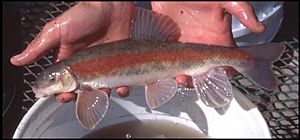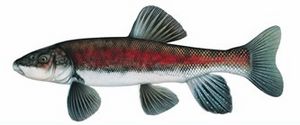Warner sucker facts for kids
Quick facts for kids Warner sucker |
|
|---|---|
 |
|
 |
|
| Conservation status | |
| Scientific classification |
The Warner sucker (Catostomus warnerensis) is a rare type of fish that lives in freshwater. It belongs to the Catostomidae family, which are often called "suckers" because of their mouth shape. This fish is found only in the Warner Basin area of Oregon in the United States. Its home range also reaches a little bit into Nevada and California.
The Warner sucker is considered a threatened species by the U.S. government. It is also known by another common name, redhorse. The International Union for the Conservation of Nature (IUCN) has listed this fish as an endangered species. This is because it lives in a very small area, is found in only a few places, and its habitat size changes a lot due to dry weather and people taking water. Because of these problems, people are working hard to help protect this special fish.
Contents
About the Warner Sucker
This type of sucker fish can grow to be about 15.75 inches (40 centimeters) long. It has a dark back and sides, and its belly is white. During the spawning season, which is when fish lay eggs, male Warner suckers and some females get a bright red color along their sides.
Life Cycle and Reproduction
Warner suckers lay their eggs in creeks when the water is high in the spring. They also use canals and the edges of lakes for spawning. These fish can live for a long time, up to twenty years! They become old enough to have their own babies when they are about three or four years old.
Where Do Warner Suckers Live?
This fish naturally lives in shallow lakes, wet marshy areas, and creeks that sometimes dry up. All these places are found in the Warner Valley in Lake County, Oregon. Warner suckers have also been seen just over the border in Nevada, in a place called Twelvemile Creek. They have also been found in West Barrel Creek, which is in California.
Long ago, there were many Warner suckers in the valley. Today, there is one main group of these fish, which is made up of several smaller groups. There are two main types, or "morphs," of Warner suckers. One type lives in the lakes, and the other stays in stream habitats even after spawning. The lake-dwelling fish are usually bigger. The stream-dwelling fish might be the only ones that are currently having new young fish join the population.
Why Are Warner Suckers in Danger?
Many things threaten the Warner sucker. One big problem is the many dams built on local creeks. These dams stop the fish from moving freely and reduce the amount of water flowing in the streams. This makes it hard for the fish to reach their spawning grounds. Also, the places where they lay eggs can get dirty and filled with too much silt (fine dirt).
Another threat comes from other fish that have been brought into the area, like the crappie (Pomoxis species). These crappies might eat young Warner suckers. Dry weather, known as drought, is also a big danger. When there is a drought, people use even more water for farming, which makes the water shortage worse for the fish.
The International Union for the Conservation of Nature (IUCN) has said this fish is an endangered species. This is because it lives in a small area, is found in only a few places, and the amount of habitat it has changes a lot.
Helping the Warner Sucker
People are working to help save the Warner sucker. One effort is to bring back plants along the riverbanks, which helps the water quality. They have also built a fishway at a dam on a major creek. A fishway is like a special ramp that helps fish get past dams.
Some Warner suckers were moved to the Summer Lake Wildlife Management Area when their homes were threatened by drought. Even though these fish later died, they were able to have babies in their new home before they passed away. These conservation efforts also help other fish, like the Great Basin redband trout (Oncorhynchus mykiss newberrii).
Images for kids
See also
 In Spanish: Catostomus warnerensis para niños
In Spanish: Catostomus warnerensis para niños




